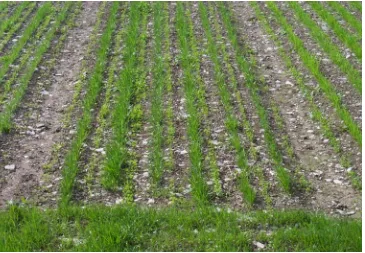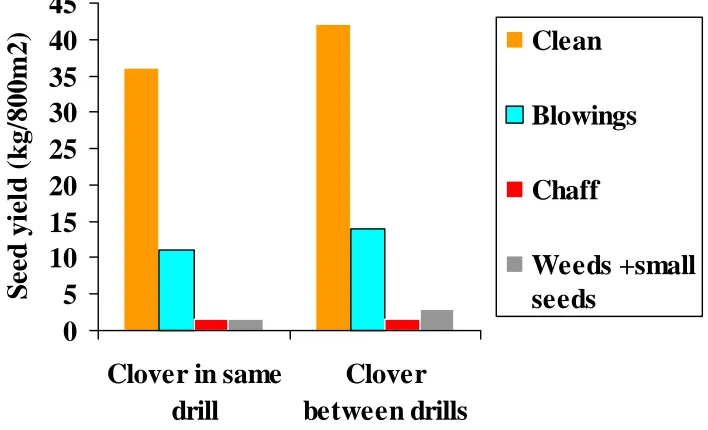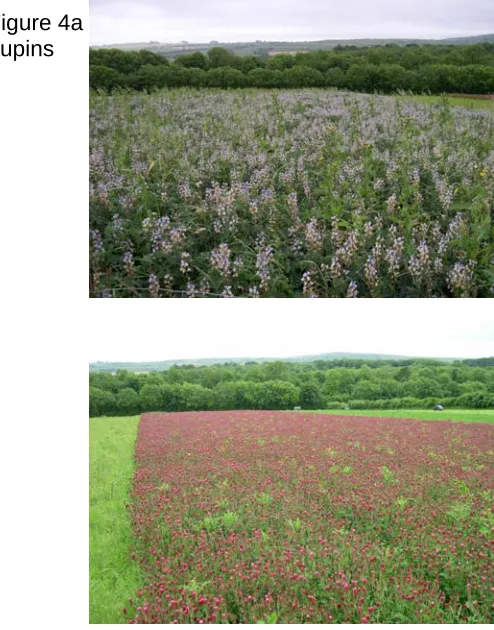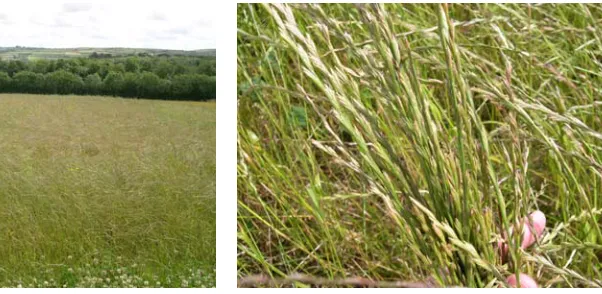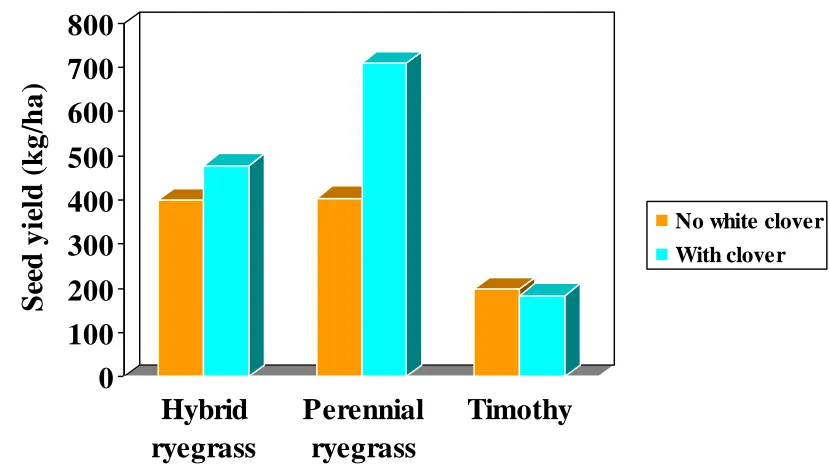Improving the Availability of
Organic Forage Seed in
Wales
Athole Marshall and Heather McCalman
IGER, Aberystwyth
A report prepared for Organic Centre Wales by IGER
Period :1/6/02-31/09/04
Published by Organic Centre Wales, Institute of Rural Studies, University of Wales Aberystwyth, Ceredigion, SY23 3AL. Tel. 01970 622248
Summary
The EU regulation requiring organic farmers to use 100% organic herbage seed is looming closer. Currently they are ‘enjoying’ a derogation from this because suitable seed is not available. For 2004 seeds mixtures had to contain at least 50% organic seed. This breathing space before full 100% organic seed is required is giving the organic industry time to improve the availability of suitable species and varieties.
Historically there was a viable herbage seed production industry in the lowland and southern areas of Wales. This area turned to livestock production during its more profitable periods, with specialist arable and herbage seed production switching largely to south east England. The agronomic potential remains in Wales but now needs to be developed to meet specific organic needs.
A recent survey of organic farmers in Wales (see Gwlad issue 26) identified persistence, total annual yield and early spring growth as the most important characters in a seeds mix. Sourcing organic seed of such forage varieties is essential for the continued development of the organic sector. Following a series of farmer discussion group meetings where these concerns were highlighted a feasibility project funded by Farming Connect, is looking at the potential of producing organic forage seed in Wales.
Experimental plot work at IGER has been addressing some of the challenges in organic forage seed production. Four farmers from organic discussion groups, with a range of farm types and systems are involved in developing this work by hosting field scale demonstration plots. Field plots, designed with farmer involvement, have focused on the feasibility of different approaches to forage grass seed production (plans are in Appendix A). Initially the emphasis has been on weed control, crop nutrition and integration of forage seed production into the farming systems using seed crops of perennial ryegrass, hybrid ryegrass and timothy. Harvesting, drying and cleaning of seed have also been addressed. The first demonstration area of the hybrid ryegrass variety AberLinnet was successfully harvested in 2003, with further areas harvested in 2004.
To involve all stakeholders, the project included Organic and Seed Certification bodies, as well as seed companies to progress organic forage seed production in Wales and to develop a better understanding of the challenges involved.
Achievements to date:
• Successful farmer participation and development of this as a route to developing organic herbage seed production agronomy and harvesting techniques.
• Inclusion of other stakeholders in meetings
• Herbage seed yields at potentially commercially viable levels on most sites
• Publication of results and project progress at a range of levels from Gwlad and organic e- bulletin to scientific and farmer conferences in Wales, UK, Europe and Australia. (Details in Appendix B)
• Dissemination of results obtained at farmer group meetings in England and Wales.
• An overview factsheet is in progress
Identification of the gaps:
• Lack of farmer confidence to proceed to commercial enterprise.
• A need to address further technical issues highlighted as a result of the initial work (eg clover variety, weed control).
• Designing sound rotations that meet with certification standards (organic and seed) needs to be addressed.
• Integration of seed production into a range of arable and or livestock systems is important to the viability and practicality of organic herbage seed production.
• The expertise and confidence of the organic growers needs to be developed.
• Developing farm scale harvesting, drying, distribution and marketing with farmers, and other stakeholders.
• Lack of active organic seed processor and marketing presence in the area
The next Phase
Detailed Progress Report
Objectives
A combination of consumer demand, agri-environmental payments and market incentives has resulted in a rapid increase in organic production in Wales which now has a target of 10% by 2005. Forage production is key to the predominantly grassland based organic systems and rotations based on white and red clover leys mean that currently reseeding is reliant on conventional seed for 65% of the mixtures. Conventional methods currently employed to achieve economic seed yields and to meet UK Seed Certification Scheme standards of quality and purity are not acceptable under organic standards. The key challenges for Welsh and UK seed producers include weed control, plant nutrient supply at specific growth stages, harvesting methods and developing the links between farmers and seed companies to build a local organic forage seed industry. Building on on-going plot work at IGER, techniques will be developed for field scale production working with a group of farmers and seed companies. This will include growing, harvesting, cleaning and drying as well as an economic appraisal and the exploring potential for local marketing.
Progress
Demonstration areas: A number of farmers, all key members of producer groups are involved in the establishment of several demonstration areas, exploring many of the practical issues associated with organic forage seed production. Decisions on ongoing management are made jointly with the participating farmers. A summary of the activities on the four current sites are described and layouts of the demonstration areas at each site are included in the Appendix. Pre-sowing, soil analysis was carried out at all sites by IGER, and where appropriate silage and manure analysis.
sample was sent to British Seed Houses for their opinion. They confirmed, “the purity of the sample was 89.7%, with 2.6% weed seeds (mainly white clover which can be cleaned out) and 7.7% inert matter. There was slightly more variability in seed size than normal but seed germination was acceptable.” One issue that arose was that the white clover was competitive and could not be controlled when the seed crop started to flower. Probably a very small leaved white clover variety would be more suitable. As this was the first site to be harvested, this has been used several times to host visits from other interested parties with the participating farmers to discuss issues pertinent to organic forage seed production (for details see Other Activities). A meeting was held at the farm of site 4 which all of the participating farmers attended where the results from this first harvest and issues that arose were discussed. Samples of the seed ex.combine and samples of seed taken during the cleaning process, as well as the clean seed were provided, providing information on the cleaning process. This area was grazed over the winter and was kept for a second harvest year in 2004. Yields in the second year are shown in Table 2. These are lower than in year 1 and further work is needed to increase them to an acceptable level.
Figure 2 Hybrid ryegrass plots in spring 2003 at site 1.
0
5
10
15
20
25
30
35
40
45
[image:7.612.110.409.67.267.2]Clover in same
drill
Clover
between drills
S
e
e
d
yi
e
ld
(
k
g/
800m
2
)
Clean
Blowings
Chaff
Weeds +small
seeds
Figure 3 Harvested clean seed yield from site 1 in 2003.
Table 1 Second year seed yields at site 1 (2004)
Treatment Seed yield
[image:7.612.125.479.314.529.2]Site 2. A demonstration area of different fertility building forage legumes (white clover, red clover, crimson clover (Figure 4), vetch and lupins) was sown on a commercial organic farm in September 2002. Silage yields from the crops were taken in 2003, the area was ploughed and the hybrid ryegrass variety (AberEcho) was sown into these fertility building legumes at the beginning of September 2003 for harvest in July 2004.
Figure 4a Lupins
Figure 4b Crimson clover
[image:8.612.104.477.595.676.2]Combine problems prevented the crop being harvested however indications from areas sampled in the plots showed that fertile tiller numbers were highest in the lupins and white clover and lowest in the crimson clover (Table 2, Figure 5).
Table 2 Ex quadrat seed yield components from site 2
Legume Tillers/quadrat Spikelets/head Seedsper spikelet
White clover 45.3 25.6 3.5
Red clover 37.0 24.5 3.4
Lupins 49.3 26.2 3.2
Vetch 38.0 24.5 2.9
Crimson clover 35.0 24.4 3.4
components are comparable with conventional. As in site 1, the weed content was low.
Figure 5 Developing crop of AberEcho at site2
Site 3. Two demonstration areas were sown on a Soil Association demonstration farm in spring 2003, looking at different options for organic forage seed production. One of these areas (Area A) aims to develop a system integrating forage grass seed production into an arable-pig rotation. This has involved undersowing a crop of the barley variety Heart with a block of white and red clover (see appendix). Part of this area was ploughed in 2004 and a ryegrass seed crop sown with the remainder ploughed and sown in 2005. Establishment of the clovers has been good.
An additional demonstration area (Area B) of several grass species (perennial ryegrass, hybrid ryegrass and timothy) sown with white clover as a companion fertility building crop has been sown and harvested in 2004. The areas of perennial ryegrass and hybrid ryegrass were not harvested however the tiller numbers were 67 and 40 fertile tillers per quadrat respectively, which were comparable with site 2 and for the hybrid ryegrass and c. 70% of the tiller numbers expected from a conventional crop of perennial ryegrass.Seed yields of timothy of were 190kg/ha and were easily cleaned to be a good seed sample.
Establishment of Area B has been good and has been topped several times to control weeds.
Figure 6 Seed crops at site 4. Crops are near harvest and are being checked for ripeness by participating farmer and IGER staff.
Figure 7 Seed yields of hybrid ryegrass, perennial ryegrass and timothy, sown with and without white clover following a crop of lupins.
Seed yields of perennial ryegrass were higher when there was white clover sown with the grass (Figure 7). In other words the amount of N provided by the lupins alone was insufficient to maximise seed yields. This was also observed in the crop itself, which failed to lodge where there was no white clover (lodging means that the crop falls over after pollination and is a prerequisite for high seed yields) but lodged very successfully where white
0
100
200
300
400
500
600
700
800
S
eed
y
iel
d
(
k
g
/h
a
)
Hybrid
ryegrass
Perennial
ryegrass
Timothy
No white clover
[image:10.612.118.533.356.589.2]clover was sown. Seed yields of the perennial ryegrass were over 700kg/ha, weed content was low and the crop was cleaned to a high standard indicating a very successful seed crop. White clover is essential to provide a high level of N and as described for site 1 , correct choice of variety is essential.
This was observed to a lesser extent in the seed crop of hybrid ryegrass and not at all in the crop of timothy where clearly there was sufficient N from the lupins to maximise seed yields, which were comparable with those obtained at site 3. Yields of hybrid ryegrass were comparable with those obtained in the 1st year of the best areas at site1.
At all sites there has been regular discussions with participating farmers to discuss issues of fencing, weed control, crop management and monitoring of crop development.
Other Activities:
1. Farmers participating in the demonstration areas have visited a commercial seed production farm growing organic and conventional herbage seed, organised by British Seed Houses. Discussions on practical grass seed production issues included harvesting, drying and cleaning. This meeting with farmers and a seed company representative gave a chance for an exchange of ideas between farmers from a range of backgrounds. Figures (Appendix D) on the gross margins of organic grass seed production (hybrid ryegrass crop) were subsequently supplied to all of the participating farmers.
2. Harvesting and cleaning equipment for grass seed production at IGER has been demonstrated to participating farmers and how this might be adapted to their own farm situations discussed.
4. A meeting on-site of participating farm(s) and farmers within their groups was held in June, to provide them with information on progress in the project. The meeting provoked some stimulating discussion and ideas on how the project could be further. A meeting was held at site 4 was held in November 2003 to look at progress at this site and to discuss the results of the harvest at site 1. A meeting on-site with seed company personnel was held in March 2004.
5. An on-site meeting of the participating farmers was held prior to the harvest of the seed crop at Site 1. This provided an opportunity to discuss some of the practical aspects of seed crop development, the decision of when a grass seed crop is ready for harvest and the various harvesting options.
A significant amount of work has been put into establishing the demonstration areas and in fostering the co-operation and involvement of the participating farmers. Meetings with the Organic certification authorities and NIAB (seed certification authorities) and seed company personnel have been very productive and they are supportive of this project. There is also potential to expand the project in future as there are a number of additional farmers interested in participating. The project will yield valuable information for factsheets and practical technical guides.
Dissemination
1. Reports on progress at each of the sites have been circulated to the participating farmers.
2. Progress in this project has been included in discussion group meetings as part of farm walks hosted by participating farmer (eg Pembrokeshire Organic Group, Llandysul and Nags Head groups) 3. Paper on organic forage seed presented at IHSG conference (Abstract
in Appendix B).
4. Poster and theatre presentation on the project to date at BGS conference, Aberystwyth in September 2003. (see Appendix B)
5. Abstracts submitted to COR conference for April 2004 and for international organic seed conference July 2004
Appendix A Site 1. Penrhiw,Llandysul,
Objective: To demonstrate the benefits of white clover as a source of N to
a grass seed crop.
Four plots (15m wide x 60 m long) of AberLinnet (hybrid ryegrass) sown
with a mix of small and medium leaved white clover. 2 plots are to be
taken for silage and receiving muck and the other 2 not taken for silage.
Plot A. AberLinnet +white clover in drill + cut for silage and muck added
Plot B. AberLinnet +white clover between drill + cut for silage, muck added
Plot C. AberLinnet +white clover in drill (no silage cut)
Plot D. AberLinnet +white clover between drill (no silage cut)
60m
A.
60m
Silage plots + muck added No silage taken
Sown- 4 September, 2002
Harvested-17 July, 2003
Site 2. Ffosyficer
Objective: to demonstrate the benefit of different legume species as fertility
building crops for grass seed crops. Sown 4 September, 2002. Five plots
(15m wide x 60m long) of different legumes will be established in year 1
and in year 2 ploughed and sown with AberEcho (hybrid ryegrass).
Plot A. AberHerald medium leaved white clover (3kg/ha)sown in year 1
and Aberlinnet in year 2.
Plot B. Merviot red clover (3kg/ha) sown in year 1 and Aberlinnet in year 2.
Plot C. Crimson clover (3kg/ha) sown in year 1 and Aberlinnet in year 2.
Plot D. Vetch ( sown in year 1 and Aberlinnet in year 2.
Plot E. Lupins (variety Lucille) (50 kgha) sown in year 1 and Aberlinnet in
year 2.
75m
60m
Site 3. Clynfyw, Boncath, Nr. Cardigan
Area A (Millenium field)- to demonstrate the use of white clover as a companion legume and source of nitrogen to different forage grasses.
54m
Fence
58m Trees
A. Perennial ryegrass (12 kg/ha) sown with white clover (3kg/ha) in same drill B. Timothy (3kg/ha, 18” drills) with white clover (3kg/ha) sown in the same
drill
C. Hybrid ryegrass (18kg/ha) with white clover (3kg/ha) in the same drill.
Sown on 8 May 2003 A
B
Area B (Pig field)- to demonstrate the potential of incorporating herbage seed production into the rotation with pigs and fertility building legumes over a 2 year period.
60m
Hedge
Barley ( ( 110kg/ha)
undersown with red clover (4kg/ha) 135m
Barley (110kg/ha) undersown with white clover
(3kg/ha)
Site 4. Rogeston Farm, Simpson’s Cross
To demonstrate the potential of lupins as fertility building crops for organic herbage seed crops and whether additional fertility is required.
40m
A.
60m
B.
C.
A. Perennial ryegrass (12kg/ha) B. Hybrid ryegrass (18kg/ha) C. Timothy (3kg/ha)
Appendix B
Abstract of paper and poster presented at The
British Grassland Society
Conference 2003
Organic grassland extension in Wales:feedback in action (2)
McCalman, H. and Marshall,A.IGER, Plas Gogerddan, Aberystwyth, Ceredigion SY23 3EB, UK
Grassland is the backbone of Welsh agriculture and agri environmental policy incentives are encouraging organic farming across Wales; the National Assembly for Wales has an organic target of 10% by 2005. The Grassland Technology Transfer Project at IGER offers a dedicated organic grassland extension service as part of its role as a partner of Organic Centre Wales. The GTTP extension programme from IGER aims to bridge the gap between the science and farming in Wales Forage production is the key to predominantly grassland based organic systems and rotations and the removal of current derogations to EU organic standards in 2005 present challenges to organic livestock farmers in Wales. Of these changes, the need for organic herbage seed is one of the most difficult to meet. Conventional herbage seed production in Wales has declined but historically has been grown in the South and South West. Following farmer discussion group meetings on grass and clover varieties, the difficulty and cost of sourcing organic seed, a feasibilty project to tackle some of the practical challenges of organic herbage seed production was set up with local farmers. The instigation and progress of this project to date is described.
This work has been delivered through the Grassland Technology Transfer project, a
Abstract , COR conference:
Organic Forage Seed Production Systems: from Research to
Farm Scale Demonstration
A.H. MARSHALL and H. McCALMAN
IGER, Plas Gogerddan, Aberystwyth, Ceredigion, UK, SY23 3EB
ABSTRACT
Forage production is the key to predominantly grassland based organic systems and rotations and the removal of current derogations to EU organic standards present significant challenges to organic livestock farmers. Of these, meeting the demand for organically produced forage seed will be one of the most difficult. The National Assembly for Wales now has an organic target of 10% by 2005 and the production of sufficient quantities of organic seed of appropriate varieties of relevant species will be hard to achieve. Conventional herbage seed production in Wales has declined but has been grown successfully in the past. Following farmer discussion group meetings on grass and clover varieties, the sourcing and cost of organic seed, a feasibility project to tackle some of the practical challenges of organic seed production was set up with local farmers. Building on small plot studies at IGER, where organic seed crop management techniques are being developed, the initial challenges and progress of this project are discussed. Results will become available over the next two years as the project develops.
Abstract : International Organic Seed Conference:
Organic Forage Seed Production:
Taking Small Plot Research to Farm Scale Development
A.H. MARSHALL and H. McCALMAN
IGER, Plas Gogerddan, Aberystwyth, Ceredigion, UK, SY23 3EB
ABSTRACT
Abstract of paper at 2003 IHSG Conference
THE USE OF WHITE CLOVER AS A SOURCE OF NITROGEN FOR ORGANIC GRASS SEED CROPS
A.H. Marshall and H. McCalman
Institute of Grassland and Environmental Research, Plas Gogerddan, Aberystwyth, Ceredigion, UK, SY23 3EB
Abstract
Appendix C
Herbage seed project
Notes from meeting at Penrhiw, Capel Dewi, Llandysul on 12 March 2003 Present: Bill Jordan (NIAB), Sarah Hardy (Soil Association), Athole Marshall (IGER), Heather McCalman (IGER), Tom Lewis Bowen, Tom Cowcher and Tom Harris.
Seed certification
Began 1940 in wpbs, only ‘certified’ seed can be sold legally now a worldwide system and is a guarantee to farmers of quality
Seed production aid is available
Lab tests include germination, purity and weed seed numbers
Crop inspection -the variety must be identified and must be a listed variety. Inspected at 5-15% ear emergence.
Sequence :Breeders seed->pre basic seed->basic seed-> certified seed and growers must maintain purity.
Previous cropping
No grass crops in previous FOUR years- (Important point in planning organic rotation- fertility building crops often are grass-clover leys).
Isolation
Check the surrounding area must be more than 50m away from a pollen source that is likely to cross-pollinate (eg silage crop, hay meadow, verge) BUT if there is farmer control over the area, such ‘crops’ can be mown to prevent heading of these areas.
Weeds
There are no field standards, just seed tests. Cut out any small areas that threaten to swamp the crop. Wild oats should be hand rogued. Blackgrass areas must be avoided.
DON’T top the crop in April, May or June because the inspector needs to be able to see the seed heads.
Organic Seed production issues
• Rotation- four year gap between grass and grass crop- need to build fertility and vice versa with clover seed- need an alternative legume. • Establishment- increase seed rate?
• Species- start with tetraploids or hybrids- as give higher yield, isolation easier, cleaning simpler.
• Growing- manure? Slurry? Rates and timings
• Harvest- to 40% moisture (tetraploids) above 40% germination can be reduced following threshing.
• Combine ryegrasses direct as there will be less sheddingSwath cocksfoot,
Organic herbage seed meeting November 2003
Hosted by Peter Storrow At Rogeston Farm On November 6th 2003
Present Peter Storrow Tom Cowcher Tom Harris
Tom Lewis Bowen Athole Marshall Heather McCalman
Review of progress at Penrhiw- (The first seed crop)
At Tom Cowchers we have been looking at the use of white clover as an N source for the growing herbage seed crop. Clover was sown within or between the grass drills and on one half an early silage crop was taken before the herbage seed harvest.
Main points from the discussions
The crop from Tom Cowcher (TC) yielded around 500-600kg/ha after it had been cleaned.
The yield was higher from the plot where the clover was grown between the drill compared with clover within the herbage seed drill. However from a practical point of view there are advantages to sowing within the drill. Drill width
Drill width was discussed and future plots would try and look at a narrower width to minimize competition from weeds.
Tom Cowchers farm
•Year 1
• Establish crops of hybrid ryegrass with legume companion
Hybrid ryegrass AberLinnet
Hybrid + clover in drill
Hybrid + clover between drills
Hybrid + clover in drill
Hybrid + clover between drills
Silage cut + muck added No silage cut
60m
60m
Harvested seed yield
0 5 10 15 20 25 30 35 40 45
Nutrient supply
Soil tests taken at Penrhiw are not expressed in ‘indexes ‘ but Were:
High for K, Ca, Mg, Medium for P With a pH of 5.42
suggested that lime would be needed but that values for P & K were at least adequate.
Analysis of FYM applied ( expressed as fertilizer value freshwt) applied was: 16% DM
Total N 4.98kg/t Available N 0.45kg/t Total P 2.2kg/t Total K4.6 kg/t
Silage cutting
Even in such a favourable year (weather), there was insufficient time for a reasonable re-growth for a herbage seed crop following a silage cut. The analysis of the silage was:
72 D, 12.2 CP, 11.6 ME
Grazing days – this information to be retrieved from Tom C’s records
Seed cleaning and drying
Methods of cleaning and drying were explored and it was noted that it is very important that the drying is slow and with minimal movement. The process is very different from cereal drying in that respect. The use of a box system similar to that at IGER using hardboard sides and mesh base was discussed. An alternative could be Hessian sacks
‘Hotspot’ drying – dismissed as in-appropriate for herbage seed although is OK for cereal grain.
Need to organize within the group- perhaps one farm to take on the cleaning and drying?
Value of fertility building crops
‘Prima’ lupins at Rogerston farm yielded about 0.75t/acre? With an analysis of 24-28% CP, 15MJ/kg DM ME, 6 % oil Results awaited from Ffosyficer (next year?)
Discussion points
Rotation planning to take account of fertility building and ‘gap’ between ryegrass in the field, while capitalizing on usual ‘cash crops’ like cereal seed and grain for processing of feed.
At Ffosyficer the proposed site for the next seed crop has been under roots, spring peas, triticale, and will be put down to a red clover monoculture
preceeding the seed crop and the use of slurry to provide nitrogen during the seed crop growth.
Entry point following roots (stubble turnips) and then a white clover under-storey direct drilled with wheat, wheat , barley and then ploughed for seed crop.
Main challenges for bicropping: Weed control, especially grass weeds
Ensuring good seed soil contact for establishment of cereal crop without herbicides
Selecting suitable clover variety for good N fixation but not too aggressive.
Appendix D: Note –these are approximate figures taken on basis of current knowledge and should not be regarded as definitive
ORGANIC TETRAPLOID HYBRID RYEGRASS SEED PRODUCTION COSTINGS (APPROX.)
Introduction:-
a) The costings below are calculated to approximate round figures. b) Estimated cleaned certified seed out-turn is 700 Kg/Ha.
c) Estimated as-grown seed sent for cleaning is 785 Kg/Ha (i.e. 112% of cleaned material)
ITEM DETAIL Cost/Ha
Stock Seed 12 Kg/Ha @ £8.25 Kg/Ha £100.00
Crop Entry Fees Defra charge = £10.00 per Ha £10.00
Crop Inspection Fees Defra charge = £13.00 per Ha £13.00
Testing Fees £50.00 per lot (average seed lot size = 5,000 Kg) £7.00
Certification Fees Defra charge = £70.00 per lot) £10.00
1st. Cleaning Charge Based on Intake weight @ £1.90 per 50 Kg) £30.00
2nd. Cleaning Charge Based on Cleaned weight @ £3.10 per 50 Kg) £40.00
Approximate Total Costings £210.00/Ha
Approximate Value of cleaned certified Organic Tetraploid Ryegrass Seed = £75.00 per 50 Kg.
Estimated Gross Income £1050.00/Ha
Estimated Variable Costs £210.00/Ha
Estimated Gross Margin £840.00/Ha
(Plus Single Farm Payment, as confirmed by EU) £230.00/Ha (?)
N.B. Organic Farmers' mechanical costings to be calculated individually by Growers
Handout to farmers at discussion group meetings :
Organic Forage Seed Production Project
Summary
A combination of consumer demand, agri-environmental payments and market incentives has resulted in a rapid increase in organic production in Wales which now has a target of 10% by 2005. Forage production is key to the predominantly grassland based organic systems and rotations based on white and red clover leys mean that currently reseeding is reliant on conventional seed for 65% of the mixtures. Conventional methods currently employed to achieve economic seed yields and to meet UK Seed Certification Scheme standards of quality and purity are not acceptable under organic standards. From January 2004 EU regulation 2092/91 states seed used in organic systems must be produced to organic standards. There is a high demand for organic seed to meet the producers needs and currently much seed is sourced from abroad. The key challenges for Welsh and UK seed producers include weed control, plant nutrient supply at specific growth stages, harvesting methods and developing the links between farmers and seed companies to build a local organic forage seed industry. Building on on-going plot work at IGER, techniques will be developed for field scale production working with a group of farmers and seed companies. This will include growing, harvesting, cleaning and drying as well as an economic appraisal and the exploring potential for local marketing. A. Four farms 'recruited' and plots sown
1) Use of clover as N source
(hybrid ryegrass and small and medium leaved clovers between/within drill and with/without silage/muck)
2) Use of different legumes for fertility build(White clover/red clover/ vetch/lupins)Response of different grass species (perennial ryegrass, italian ryegrass, hybrid ryegrass and Timothy) to red or white clover in fertility building phase.
